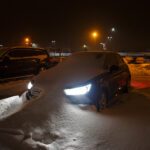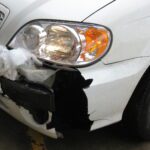Winter driving is tough enough without a seemingly minor mishap sending you looking for dependable plastic bumper repair. Winter’s extreme cold combined with the compact nature of something as innocent-looking as a snowbank pose serious threats to all plastic auto parts. The early days of 2021 in Madison WI left roads, driveways and parking lots covered – with vehicle damage threats lurking beneath the surface.
Vehicle-makers went to plastic parts and plastic bumper covers to reduce weight and improve gas mileage. In Wisconsin’s frigid winters plastic gets brittle. It cracks easily, without much pressure. In July a plastic auto body panel or bumper cover will flex. In February the same pressure produces a crack. Which plastic parts are most likely to crack or break during a run in with a snow bank? The top prospects for mid-winter repairs include:
- Front end air dams
- Plastic bumpers and plastic bumper covers
- Under-engine shields
- Wheel well liners
- Rearview mirror housings
- Headline lenses and trim
- Grill panels
A typical freeze/thaw cycle in southern Wisconsin makes the snowbanks crowding parking spots hard and unyielding. Combine that with a slick surface and sliding into trouble while parking is a real threat. It’s the same with the banks piling up at the end of your driveway. In addition, those fluffy-looking snow drifts often mask even more threats – landscaping rocks, fire hydrants, etc. You cannot always avoid sliding into a snowbank can you? But it’s obviously not something to take lightly.
Get ‘Defensive’ And Avoid Plastic Bumper Repair

It looks soft, but is it? Don’t count on it – snow drifts are top contributors to plastic bumper repairs.
A lot is written about defensive driving but nobody applies it to snowbanks. It’s only snow, right? Well, plowing through that rubble the plow left at the end of the driveway is like plowing through boulders of ice.
Front bumper air dams on modern cars are made of thin plastic. They’re fragile and get crispy when it’s below freezing. Snow packed by plows easily snaps it off. When you hit a rock-hard layer of ice chunks you’re lucky of you only break the ice dam and don’t crack the plastic bumper cover, too. Is it worth a few minutes of extra time to chop away the debris left by neighborhood plow crews rather than blasting through it? Consider the time you’ll lose on top of the cash outlay if you miscalculate.
The shielding under your engine is vulnerable to road debris – frozen chunks of ice left behind by plows or falling off passing trucks for example.
Every vehicle and every snowbank is different. Modern cars ride low to the ground and it takes less to damage rocker panels, wheel wells and bumpers. SUVs and trucks have road clearance but they aren’t immune to ice and snow. A snowbank may be clean and soft-looking or ugly gray and foreboding. Either can hide a solid object underneath. What you hit and how hard you hit it determines damage potential. Even snow jammed into the radiator can cause overheating and even more problems.
The bottom line? As you pull into that parking spot, cruise a parking lot or bust your way into your driveway remember: Hitting a snowbank can be like hitting a stone wall. Ice is hard!
Winter Auto Body Damage – Focus Up Front
In minor fender bender collisions most auto body damage is in the front end. That includes bouncing off snowbanks. But winter driving vehicle damage isn’t limited to any one part of a vehicle. The areas getting the most attention in local body shops in winter include:
- Front bumper damage – when there’s a rear-end collision the front bumper making the hit accounts for most of the damage. In addition, the front end is vulnerable to impact from snowbanks, shovels, snow throwers and a variety of obstacles. Plastic and fiberglass bumper covers don’t react well in cold weather. The bumper protects the frame and rest of the car while the plastic bumper cover takes the hit.
- Headlights, frames and trim – headlights, fog lights and turn signals are high on the list of targets for damage in a front-end clash. The lights, their frames and lenses are plastic and become even more rigid than normal when it’s cold. The lights’ covering and frame give and snap under pressure of a collision.
- Fenders and doors – fenders begin in front near the lights and while not as delicate as the plastic parts, fenders take their share of abuse. Many cars, trucks and SUVs feature plastic fender flares. They get scraped, scratched and roughed up in slide-in collisions with everything from parker cars to snowbanks and garage door frames.
- The grill – the grill is a major element of the front end and a recognizable signature for many vehicles. Drivers try to swerve to avoid most front end collisions so lights and bumpers take direct hits. Even so, the grill is damaged in about 20% of all front end mishaps.
Plastic Bumper Repair – You Have Choices
Dealing with a cracked plastic bumpers you have choices. Not every crack or dent requires major repairs. Damage on flat surfaces take less work. Curved surfaces reflecting style lines or molded features like lights demand more attention. AutoColor suggests weighing repair vs. replacement. Consider:
- Repair costs less than insurance deductible– repairs often cost less than an insurance policy deductible. Avoid an insurance claim, keep premiums as low as possible.
- Far less than a new part– a replacement bumper or plastic part, plus installation time often costs more than repairs.
- Gets you on the road sooner– repairs often take less time than ordering and replacing the entire bumper and related parts.
- Environmentally-friendly– fixing minor damage keeps plastic materials from landfills (although more and more plastic gets recycled).
- Best option for older models– crack repair may be the only option for older vehicles when parts are hard to find.
Since many dings and dents this time or year are the result of low-speed collisions, many repairs revolve around high-tech paintless dent repair. Fenders, bumpers and door panels ae fairly easy to repaired without new paint. Application of paintless dent repair (PDR) techniques reduce the time and cost of dealing with minor dents. Under the right conditions, dents from the size of a dime to the size of a football are right for PDR.
Restoring cracked, dented and scratched plastic parts is an AutoColor specialty. The process focuses on timely, efficient repair rather than replacing parts. Applying the latest auto body technology, including paintless dent treatment, provides cost-effective solutions.
Call or stop into one of our local shops: in Middleton on Parmenter Road; on Madison’s East Side on Stoughton Road near Buckeye. Make AutoColor your choice to restore any mid-winter vehicle damage including plastic bumper repair in the Madison WI area.
Plastic Bumper Repair Services
How To Repair your cracked bumper
